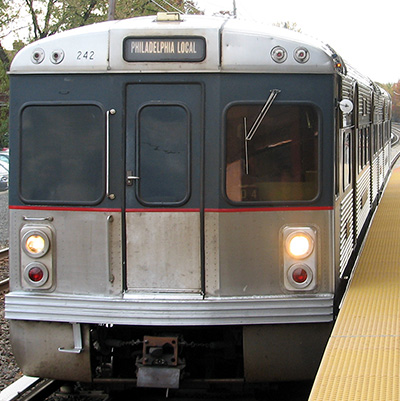
Speedline
on the SubwayNut


Port Authority Transit Corporation (PATCO) Speedline is a 14 mile, 13 station, electrified via third-rail rapid transit line connecting the city of Philadelphia, with Camden and other suburban communities in New Jersey. It is operated by the Delaware River Port Authority, a bi-state compact of New Jersey and Pennsylvania that also runs tolled crossings over the Delaware River, with separate fares from New Jersey Transit and SEPTA (except for discounted transfers to SEPTA). Trains run 24 hours a day, 7 days a week. On Weekdays trains run as frequently as every 6 to 8 minutes during rush hours, 15 minutes in the middle of the day, and 20 minutes in evenings, Saturday service is every 20 minutes, and Sunday service every half-hour, with daily hourly service overnight between about Midnight and 5:00am.
The line absorbed the former Bridge Line (operated alongside today’s SEPTA Broad Street Subway) that opened in 1932 between Camden and Philadelphia over the Ben Franklin Bridge. These are the 6 subway stations on the line. In 1969 PATCO took over operations and rebuilt the line, including the introduction of 121 PATCO I stainless steel Budd rail cars, and extended the line above ground along the former Pennsylvania-Reading Seashore Lines trackage to Lindenwold. 6 modern stations opened on this extension, all with large surface parking lots offering free parking. Today parking is mostly free with some lots overing $1.00 premium parking. A final infield station, Woodcrest opened on February 1, 1980 to provide even more parking with easy access off of I-295, and an additional 45 PATCO II train cars were purchased from Vickers Canada, under license from Budd and are nearly identical to the PATCO I cars.
The line was a modern prototype for the post-way Great Society subway, suburban-urban rapid transit lines that opened in the 1970s connecting city centers with the suburbs including San Francisco’s BART, the Washington Metro, and Atlanta’s MARTA. The line had a pioneering Automatic Signaling System and used one-person train operations, with the train operator sitting on the left-hand side of the train (normally engineers sit on the right-hand side), this is because every station has an island platform with doors opening on the left. Until the 2010s, when the fleet of Budd/Canadian Vickers cars were rebuilt from their stainless steel shells up and full-width cabs were retrofitted, passengers had a railfan window seat with the driver just divided off by a curtain (in PATCO I cars) or partition (in PATCO II cars).
The line also was the first to have a modern distance-based fare system, collected by automatic fare collection technology. Until the original system was replaced by the new FREEDOM smart card (and single-use ticket for infrequent trips) in the mid-2000s, ticketing required passengers to buy a one-way round-trip, or ten-trip ticket from a primitive vending machine that could only dispense one type of ticket. At stations in Philadelphia this required four different ticket vending machines for the four different fare zones: